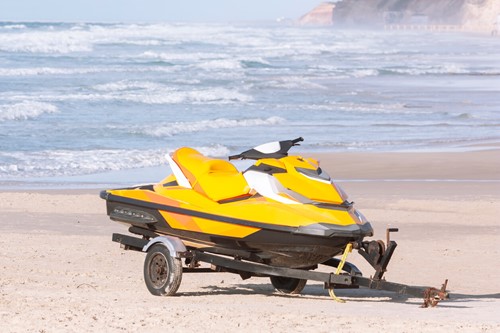The jet ski market can be complicated, even if you’re an experienced skier. So, if you’re new to jet skiing and are in the market for a used model at the moment, you could be forgiven for having one or two questions about what to look for.
Used jet skis are typically cheaper than buying brand new, thus making them a lot more attractive— particularly to first-time, inexperienced buyers.
But with so much variety and competition out there, it’s easy to get caught out if you’re not clued up. From disguised faulty parts to rogue sellers (unfortunately, they do exist), it’s not unusual to face certain obstacles when buying a used jet ski, so you need to know what to look for.
Of course, you’ll want to check the jet ski’s general condition, look and feel, but some things may go unnoticed by the untrained eye. However, fear not. We’ve got your back.
In no particular order, here’s what to look for when buying a used jet ski.
1. Check its hours and service history

Just as your car clocks its miles travelled, your jet ski clocks its hours on the water.
The average jet ski has a lifespan of roughly 300 hours. Although this might not sound a lot on paper, considering you wouldn’t typically use your jet ski all year round. 300 hours should represent a good few years as far as your vehicle’s shelf-life is concerned.
Always ask the seller how long they’ve had the jet ski for, too, as knowing this as well as its hours will help paint a picture of how often the vehicle has been used.
For this reason, hours are an important factor, but they shouldn’t be the decider. After all, a jet ski can be riddled with problems regardless of whether it’s got 20 or 200 hours on the clock.
Perhaps a more important thing to look for when buying a used jet ski is its service history.
Most jet ski manufacturers recommend a routine servicing either every 12 months or 50 hours, whichever comes first—but this often depends on its level of usage.
Never agree to buy a used jet ski without first asking the seller for access to its service logbook. This will allow you to see when the vehicle was last serviced, thus giving you a better indication of what condition the vehicle is in, whether it’s suitable for the water, and, of course, worth the seller’s asking price.
Don’t base your purchase purely on what the eye can see. Some problems are invisible, so it pays to ask questions. You’ll thank yourself later.
Related: How to check hours on jet skis (everything you should know)
2. Look for water in the hull
Don’t be alarmed if there’s a small amount of water in the jet ski hull (we’re talking a cup or two)—that’s completely normal. No matter how watertight your jet ski is, some water is always bound to get in.
However, if there’s a fairly substantial amount of water in the hull, it could mean several things:
- either the hull hasn’t been drained properly after a clean
- there’s a leak
- the drain plugs have been left out
While excess water in the hull is often easy to drain, its presence can indicate structural issues with the jet ski, which you’ll want to know about and look to resolve before purchasing.
Related: 7 best ways to remove water from a jet ski hull [VIDEO]
3. Check its security
Nobody likes to admit it, but jet skis are a prime target for thieves. So, another thing you want to look for when buying a used one is its security, particularly its scope for anti-theft devices.
The way jet skis are locked and secured depends on the manufacturer and model. For example, some will have security tabs and lanyards, others will be pin or fob-protected, and some older models may even be equipped with an immobiliser.
Ask the seller about their experiences with theft, attempted theft, and the measures they’ve gone to with that particular jet ski. You need to be aware of the risk you’re taking on.
Related: Jet ski security – 13 very practical anti-theft measures
4. Inspect the top deck and seats

The seller’s advert will probably contain relevant information about the general condition of the jet ski, but you’ll still need to get up close and personal to check whether it really is up to scratch.
While the base of the jet ski is subject to abrasion and water damage, you should expect some general wear and tear on the upside and seats, too—particularly on older models with more miles on the clock.
This is completely normal, so don’t be alarmed. But, you need to be wary of things like ‘botched’ repairs, existing faults that are merely being covered up, or mismatched paintwork. The latter, in particular, could indicate the previous owner has dabbled in some DIY, and you’ll want to know why.
Have a close look at the seats for rips or loose stitching, and ask the seller if the seats are original or if there have been any repairs or refits carried out historically.
If the jet ski has side mirrors, too, check that these are fitted properly and securely. You don’t want to get out on the water and find they’re loose.
Related: How to care for the vinyl on your PWC seat
5. Water test the jet ski

Would you buy a car without taking it for a test drive? Buy a house without having a look around?
Of course, you wouldn’t, so why would you with a jet ski? While the seller will probably assure you everything’s running smoothly, taking it out on the water yourself is the only way you’ll know for sure, regardless of how much you trust the seller.
The overall performance of jet skis differs depending on the manufacturer or model, so you should never chance it. You don’t want to fork out a potentially large sum of money to then realise it’s not what you were expecting.
After all, looking the part isn’t everything.
Here are several things to look out for when doing a water test:
- check the warning lights (these shouldn’t be on)
- ensure the jet ski can maintain consistent RPMs (this is normally 7,000 or above)
- test the brakes
- monitor the fuel consumption
- get a general feel for the engine, ease of steering and acceleration
Keep a mental tally while out on the water, and ask the seller about anything that stood out when you’re back on dry land.
Related: Jet ski pre-ride checklist—what to check before launch [VIDEO]
6. Check the trailer

Despite all your excitement surrounding the jet ski itself, don’t forget the trailer, too. Your jet ski is pretty useless on land without a trailer, so it needs to be in good condition if you’re buying it.
Here are the main things you’ll want to consider when looking at the trailer:
- look out for signs of corrosion on the frame
- check how the fittings align with the jet ski hull
- check the tail-lights work properly
- strength-test the straps and jockey wheel
- assess the condition of the tyres
The shelf-life of a jet ski trailer depends on the manufacturer and how well it’s kept, but most are built to last between 8-10 years. So, with that in mind, ask the seller how old it is.
If it’s nearing or above 8-10 years old, you may want to factor in the additional costs of a new trailer (or tyres, at least) before purchasing.
This leads us nicely onto the next point…
Related: Tips on how to maintain your jet ski trailer
7. Factor in additional costs
As any jet ski owner will vouch—what you see at face value is never the full story when it comes to jet skis. There will always be additional costs to consider, so firstly, you need to make sure you understand what you’re signing up for, and secondly, that you can afford it.
You can normally whittle additional costs down to four main categories:
- insurance
- trailer
- accessories
- maintenance
Of course, we couldn’t let you forget jet ski insurance. Used or not, jet skis come at a high cost and need to be insured to protect you and your vehicle.
As we outlined above, you might also need to invest in a new trailer or trailer parts, depending on the condition of the one advertised. Even second-hand trailers are very rarely cheaper than £1,000.
From quirky gadgets to essential safety add-ons, you’ll probably want to buy some accessories for your jet ski, too. Some of these aren’t cheap either. Check out our round-up of ten must-have jet ski accessories here.
No matter how careful you are with your jet ski, accidents and the need for occasional repairs and maintenance are inevitable. If you think the spending stops once you’ve bought your jet ski, you’ve got another thing coming.
Related: Hidden costs to owning a jet ski
8. Make sure you know the engine type
Like many jet ski features, the engines differ depending on the make and model.
Though you don’t necessarily need to become an engine expert, it pays to know the basics, as the engine size plays an important part in the overall performance of the jet ski. By and large, most jet ski engines are either 2-stroke or 4-stroke.
Imagine a ‘stroke’ as though it’s your arm when swimming to make things simple. It glides from the top of your body downwards to propel you forwards through the water. Now, imagine the engine pistons doing the same, instead moving the jet ski forward. The principle is the same (in theory).
This is what’s known as the combustion cycle. The main difference between a 2-stroke and 4-stroke jet ski engine is how fast this cycle occurs.
A 2-stroke engine piston moves up and down once during a single combustion cycle, while a 4-stroke engine will do so twice.
The engine type impacts the jet ski in several ways. The ones you’ll probably notice the most are:
- 2-stroke engines are a lot lighter and easier to handle
- 2-stroke engines are much easier to repair
- 4-stroke engines are much quieter
- 4-stroke engines tend to last longer
Of course, there are many more differences between these two engine types—but we won’t go into all of them here. Do your research, though, as it could well be a deciding factor in your purchase.
Related: Jet ski engine and pump explained?
9. Check the bilge pump works
The bilge pump is an essential part of a jet ski. They have various functions but are primarily used to get rid of unwanted water from the bilge (the part underneath the hull).
As discussed previously, it’s normal for some water to find its way into the hull and subsequently the bilge, but too much can be problematic and can even cause the jet ski to sink.
Testing the bilge pump regularly is essential for jet ski safety and could help you avoid a disaster further down the line. But don’t wait until you’ve bought the jet ski outright before you test it for the first time. Ideally, check it works when you view it and ask the seller about historic maintenance.
Related: Jet ski bilge pump (what is it and when to use it)
10. Ask the seller about compression tests
Last but by no means least on our list of what to look for when buying a used jet ski is the compression test. However, this is less of something to look for but more of something to do.
A compression test will reveal the condition of the jet ski’s engine valves, valve seats and piston rings, and whether any of these components need maintenance.
Compression tests can be complicated, so you’ll either need to get clued up first or hire a qualified mechanic (with permission from the seller, of course). These tests can fully drain the jet ski battery, so some sellers may be reluctant to let you proceed.
However, these tests are important, so you’ll need to stand firm with the seller.
Generally speaking, somewhere between 110-130 PSI is considered a ‘good’ result for a 2-stroke engine, while you should be aiming for between 180-210 PSI with a four-stroke engine.
So, again, it’ll pay to know which engine type you’re dealing with.
Related: Performing a simple compression test on a jet ski
Specialist jet ski insurance from Insure4Boats
If you’re thinking of buying, or have recently bought, a used jet ski, you mustn’t forget to also purchase insurance – not just to protect you but your jet ski, too.
Second hand or not, jet skis can come at a high cost. With that in mind, our specialist jet ski insurance policies are designed to cover you against theft, loss, and damage up to the value of £20,000.
We also offer third party liability up to £1m, which protects you should you be responsible for injury to others or damage to other jet skis. Therefore, you can spend less time worrying and more time doing what you love.
Click below to learn more about our specialist jet ski insurance and get an instant online quote today.
Related
7 Common Jet Ski Injuries And How To Avoid Them
The 10 Best Jet Ski Locations In The UK
10 Must-Have Jet Ski Accessories
Please note the information provided on this page should not be taken as advice and has been written as a matter of opinion. For more on insurance cover and policy wording, see our homepage.


